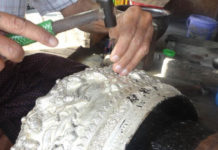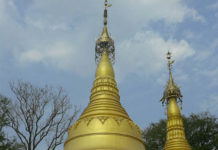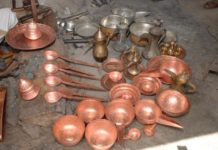Traditional armory art has a special place in Kazakh cultural heritage. Today traditional armory is a status thing, souvenir or interior accessory. The variety of Kazakh armory makes clear its enormous complexity and dates back to great antiquity. It has always received great interest and acclaim from researchers. Many middle-age travelers and historians like Fazlallah ibn Ruzbihan Isfahani, Rashid al-Din Ṭabib, M.H. Dulati, Mahmud al-Kashgari, Giovanni da Pian del Carpine, William of Rubruck highlighted Kazakh traditional armory in their works. As well it is mentioned in Kazakh folklore and epics.
Today the basic types of armory have not varied. Kazakh traditional armory is divided into parade and combat weaponry. Combat armory includes sharp piercing through armory (a bow with arrows, spear, pike), cut and thrust weapons (daggers, knives, sword, saber, axe, hatchet, shashka, shaqan, blunt weapons (mace, bludgeon, flail) and protective combat gear.
Parade armory is worn on a leather belt (kisse-beldyk) and usually is decorated with precious metals and stones (saber, qylysh and knife, pyshaq). One of the most widespread weapons is aybalta (the edge of the hoard is shaped as a crescent). It has a long haft and the width of the hoard can be narrow (up to 10 cm) or wide (more than 10 cm). Another unique weapon is qamshy-pyshaq, a knife hidden in a handle of a whip.
Metal that is used for armory production is iron, steel, bulat steel, sometimes copper and bronze. Bulat steel or almas is divided into qyzyl almas (red steel) and aq almas (white steel) and is used for production of daggers, knives, swords, sabers, shashkas. Copper and brass is used for making of protective combat armor, sheath, and other gear. Lead and tin is used for assembling armory and as welding mixtures for soldering of metal. Processing of metals include hot and cold forging, remelting, casting.
Kazakh traditional armory is famous for its decoration. For example, granulation is used for knife handles and sheath. Armory is widely decorated with engraving, silvering (kumyspen kupteu), gilding (altynmen aptau), niello (qara bagdar), silver wire inlay. As well, precious and semi-precious stones are used (sapphire, ruby, turquoise, pearl and carnelian). The design is traditionally based on plant pattern like tree of life and others.
Combat gear or zharaq are of two types: body and head armor (yer kyim) and protective gear (qol zharaq) like shields made of leather decorated with embossing and metal plates. Leather shields are up to 70 cm in diameter and 2-3 cm thick including felt padding.
Modern armory craftsmen include Kulmenov brothers, Ye. Askarov, B. Alibay, S. Argyn, Ye. Abilov, A. Moldakhanov, B. Atamkulov, Ye. Baubai, K. Altynbekov, M. Abdrakhmanov, Kanapin brothers, P. Trybunskiy, S. Kokenov, S. Taskin, N. Zheyerechiyev and B. Zhakypov.




